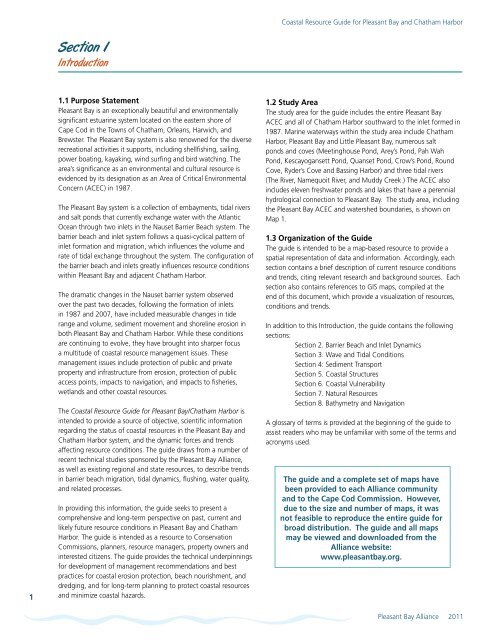Coastal Resource Guide Pleasant Bay and Chatham Harbor
Coastal Resource Guide Pleasant Bay and ... - Town to Chatham
Coastal Resource Guide Pleasant Bay and ... - Town to Chatham
Create successful ePaper yourself
Turn your PDF publications into a flip-book with our unique Google optimized e-Paper software.
<strong>Coastal</strong> <strong>Resource</strong> <strong>Guide</strong> for <strong>Pleasant</strong> <strong>Bay</strong> <strong>and</strong> <strong>Chatham</strong> <strong>Harbor</strong><br />
Section 1<br />
Introduction<br />
1<br />
1.1 Purpose Statement<br />
<strong>Pleasant</strong> <strong>Bay</strong> is an exceptionally beautiful <strong>and</strong> environmentally<br />
significant estuarine system located on the eastern shore of<br />
Cape Cod in the Towns of <strong>Chatham</strong>, Orleans, Harwich, <strong>and</strong><br />
Brewster. The <strong>Pleasant</strong> <strong>Bay</strong> system is also renowned for the diverse<br />
recreational activities it supports, including shellfishing, sailing,<br />
power boating, kayaking, wind surfing <strong>and</strong> bird watching. The<br />
area’s significance as an environmental <strong>and</strong> cultural resource is<br />
evidenced by its designation as an Area of Critical Environmental<br />
Concern (ACEC) in 1987.<br />
The <strong>Pleasant</strong> <strong>Bay</strong> system is a collection of embayments, tidal rivers<br />
<strong>and</strong> salt ponds that currently exchange water with the Atlantic<br />
Ocean through two inlets in the Nauset Barrier Beach system. The<br />
barrier beach <strong>and</strong> inlet system follows a quasi-cyclical pattern of<br />
inlet formation <strong>and</strong> migration, which influences the volume <strong>and</strong><br />
rate of tidal exchange throughout the system. The configuration of<br />
the barrier beach <strong>and</strong> inlets greatly influences resource conditions<br />
within <strong>Pleasant</strong> <strong>Bay</strong> <strong>and</strong> adjacent <strong>Chatham</strong> <strong>Harbor</strong>.<br />
The dramatic changes in the Nauset barrier system observed<br />
over the past two decades, following the formation of inlets<br />
in 1987 <strong>and</strong> 2007, have included measurable changes in tide<br />
range <strong>and</strong> volume, sediment movement <strong>and</strong> shoreline erosion in<br />
both <strong>Pleasant</strong> <strong>Bay</strong> <strong>and</strong> <strong>Chatham</strong> <strong>Harbor</strong>. While these conditions<br />
are continuing to evolve, they have brought into sharper focus<br />
a multitude of coastal resource management issues. These<br />
management issues include protection of public <strong>and</strong> private<br />
property <strong>and</strong> infrastructure from erosion, protection of public<br />
access points, impacts to navigation, <strong>and</strong> impacts to fisheries,<br />
wetl<strong>and</strong>s <strong>and</strong> other coastal resources.<br />
The <strong>Coastal</strong> <strong>Resource</strong> <strong>Guide</strong> for <strong>Pleasant</strong> <strong>Bay</strong>/<strong>Chatham</strong> <strong>Harbor</strong> is<br />
intended to provide a source of objective, scientific information<br />
regarding the status of coastal resources in the <strong>Pleasant</strong> <strong>Bay</strong> <strong>and</strong><br />
<strong>Chatham</strong> <strong>Harbor</strong> system, <strong>and</strong> the dynamic forces <strong>and</strong> trends<br />
affecting resource conditions. The guide draws from a number of<br />
recent technical studies sponsored by the <strong>Pleasant</strong> <strong>Bay</strong> Alliance,<br />
as well as existing regional <strong>and</strong> state resources, to describe trends<br />
in barrier beach migration, tidal dynamics, flushing, water quality,<br />
<strong>and</strong> related processes.<br />
In providing this information, the guide seeks to present a<br />
comprehensive <strong>and</strong> long-term perspective on past, current <strong>and</strong><br />
likely future resource conditions in <strong>Pleasant</strong> <strong>Bay</strong> <strong>and</strong> <strong>Chatham</strong><br />
<strong>Harbor</strong>. The guide is intended as a resource to Conservation<br />
Commissions, planners, resource managers, property owners <strong>and</strong><br />
interested citizens. The guide provides the technical underpinnings<br />
for development of management recommendations <strong>and</strong> best<br />
practices for coastal erosion protection, beach nourishment, <strong>and</strong><br />
dredging, <strong>and</strong> for long-term planning to protect coastal resources<br />
<strong>and</strong> minimize coastal hazards.<br />
1.2 Study Area<br />
The study area for the guide includes the entire <strong>Pleasant</strong> <strong>Bay</strong><br />
ACEC <strong>and</strong> all of <strong>Chatham</strong> <strong>Harbor</strong> southward to the inlet formed in<br />
1987. Marine waterways within the study area include <strong>Chatham</strong><br />
<strong>Harbor</strong>, <strong>Pleasant</strong> <strong>Bay</strong> <strong>and</strong> Little <strong>Pleasant</strong> <strong>Bay</strong>, numerous salt<br />
ponds <strong>and</strong> coves (Meetinghouse Pond, Arey’s Pond, Pah Wah<br />
Pond, Kescayogansett Pond, Quanset Pond, Crow’s Pond, Round<br />
Cove, Ryder’s Cove <strong>and</strong> Bassing <strong>Harbor</strong>) <strong>and</strong> three tidal rivers<br />
(The River, Namequoit River, <strong>and</strong> Muddy Creek.) The ACEC also<br />
includes eleven freshwater ponds <strong>and</strong> lakes that have a perennial<br />
hydrological connection to <strong>Pleasant</strong> <strong>Bay</strong>. The study area, including<br />
the <strong>Pleasant</strong> <strong>Bay</strong> ACEC <strong>and</strong> watershed boundaries, is shown on<br />
Map 1.<br />
1.3 Organization of the <strong>Guide</strong><br />
The guide is intended to be a map-based resource to provide a<br />
spatial representation of data <strong>and</strong> information. Accordingly, each<br />
section contains a brief description of current resource conditions<br />
<strong>and</strong> trends, citing relevant research <strong>and</strong> background sources. Each<br />
section also contains references to GIS maps, compiled at the<br />
end of this document, which provide a visualization of resources,<br />
conditions <strong>and</strong> trends.<br />
In addition to this Introduction, the guide contains the following<br />
sections:<br />
Section 2. Barrier Beach <strong>and</strong> Inlet Dynamics<br />
Section 3. Wave <strong>and</strong> Tidal Conditions<br />
Section 4: Sediment Transport<br />
Section 5. <strong>Coastal</strong> Structures<br />
Section 6. <strong>Coastal</strong> Vulnerability<br />
Section 7. Natural <strong>Resource</strong>s<br />
Section 8. Bathymetry <strong>and</strong> Navigation<br />
A glossary of terms is provided at the beginning of the guide to<br />
assist readers who may be unfamiliar with some of the terms <strong>and</strong><br />
acronyms used.<br />
The guide <strong>and</strong> a complete set of maps have<br />
been provided to each Alliance community<br />
<strong>and</strong> to the Cape Cod Commission. However,<br />
due to the size <strong>and</strong> number of maps, it was<br />
not feasible to reproduce the entire guide for<br />
broad distribution. The guide <strong>and</strong> all maps<br />
may be viewed <strong>and</strong> downloaded from the<br />
Alliance website:<br />
www.pleasantbay.org.<br />
<strong>Pleasant</strong> <strong>Bay</strong> Alliance 2011
















